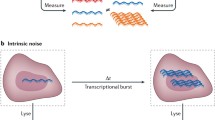Abstract
Microfluidic systems in combination with microscopy (e.g., fluorescence) can be a powerful tool to study, at single-cell level, the behavior and morphology of biological cells after uptake of glucose. Here, we briefly discuss the advantages of using microfluidic systems. We further describe how microfluidic systems are fabricated and how they are utilized. Finally, we discuss how the large amount of data can be analyzed in a “semi-automatic” manner using custom-made software. In summary, we provide a guide to how to use microfluidic systems in single-cell studies.
Similar content being viewed by others
References
Bendrioua L, Smedh M, Almquist J, Cvijovic M, Jirstrand M, Goksor M, Adiels CB, Hohmann S (2014) Yeast AMP-activated protein kinase monitors glucose concentration changes and absolute glucose levels. J Biol Chem 289(18):12863–12875. https://doi.org/10.1074/jbc.M114.547976
Steinmetz EJ, Brow DA (1998) Control of pre-mRNA accumulation by the essential yeast protein Nrd1 requires high-affinity transcript binding and a domain implicated in RNA polymerase II association. Proc Natl Acad Sci U S A 95(12):6699–6704
Treitel MA, Kuchin S, Carlson M (1998) Snf1 protein kinase regulates phosphorylation of the Mig1 repressor in Saccharomyces Cerevisiae. Mol Cell Biol 18(11):6273–6280
Elbing K, Stahlberg A, Hohmann S, Gustafsson L (2004) Transcriptional responses to glucose at different glycolytic rates in Saccharomyces cerevisiae. Eur J Biochem 271(23–24):4855–4864. https://doi.org/10.1111/j.1432-1033.2004.04451.x
Elbing K, Larsson C, Bill RM, Albers E, Snoep JL, Boles E, Hohmann S, Gustafsson L (2004) Role of hexose transport in control of glycolytic flux in Saccharomyces cerevisiae. Appl Environ Microbiol 70(9):5323–5330. https://doi.org/10.1128/aem.70.9.5323-5330.2004
Lin Y, Sohn CH, Dalal CK, Cai L, Elowitz MB (2015) Combinatorial gene regulation by modulation of relative pulse timing. Nature 527(7576):54–58. https://doi.org/10.1038/nature15710
Zambon A, Zoso A, Luni C, Frommer WB, Elvassore N (2014) Determination of glucose flux in live myoblasts by microfluidic nanosensing and mathematical modeling. Integr Biol (Camb) 6(3):277–288. https://doi.org/10.1039/c3ib40204e
Eriksson E, Sott K, Lundqvist F, Sveningsson M, Scrimgeour J, Hanstorp D, Goksor M, Graneli A (2010) A microfluidic device for reversible environmental changes around single cells using optical tweezers for cell selection and positioning. Lab Chip 10(5):617–625. https://doi.org/10.1039/b913587a
Whitesides GM (2006) The origins and the future of microfluidics. Nature 442(7101):368–373. https://doi.org/10.1038/nature05058
Cademartiri L, Ozin GA (2009) Concepts of nanochemistry. Wiley, Weinheim
Eriksson E, Engstrom D, Scrimgeour J, Goksor M (2009) Automated focusing of nuclei for time lapse experiments on single cells using holographic optical tweezers. Opt Express 17(7):5585–5594
Kvarnstrom M, Logg K, Diez A, Bodvard K, Kall M (2008) Image analysis algorithms for cell contour recognition in budding yeast. Opt Express 16(17):12943–12957
Smedh M, Adiels CB, Sott K, Goksör M (2010) CellStress—open source image analysis program for single-cell analysis. Proc SPIE Int Soc Opt Eng 7762. https://doi.org/10.1117/12.860403
Dimopoulos S, Mayer CE, Rudolf F, Stelling J (2014) Accurate cell segmentation in microscopy images using membrane patterns. Bioinformatics 30(18):2644–2651. https://doi.org/10.1093/bioinformatics/btu302
Chernomoretz A, Bush A, Yu R, Gordon A, Colman-Lerner A (2008) Using Cell-ID 1.4 with R for microscope-based cytometry. Current protocols in molecular biology/edited by Frederick M Ausubel [et al] Chapter 14:Unit 14.18. doi:https://doi.org/10.1002/0471142727.mb1418s84
Acknowledgements
We wish to acknowledge the Science Faculty of the University of Gothenburg for financing and supporting the PDMS Microfluidic Fabrication Facility.
Author information
Authors and Affiliations
Corresponding author
Editor information
Editors and Affiliations
Rights and permissions
Copyright information
© 2018 Springer Science+Business Media LLC
About this protocol
Cite this protocol
Welkenhuysen, N., Adiels, C.B., Goksör, M., Hohmann, S. (2018). Applying Microfluidic Systems to Study Effects of Glucose at Single-Cell Level. In: Lindkvist-Petersson, K., Hansen, J. (eds) Glucose Transport. Methods in Molecular Biology, vol 1713. Humana Press, New York, NY. https://doi.org/10.1007/978-1-4939-7507-5_9
Download citation
DOI: https://doi.org/10.1007/978-1-4939-7507-5_9
Published:
Publisher Name: Humana Press, New York, NY
Print ISBN: 978-1-4939-7506-8
Online ISBN: 978-1-4939-7507-5
eBook Packages: Springer Protocols




